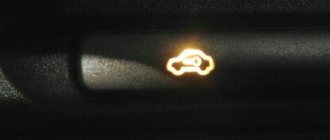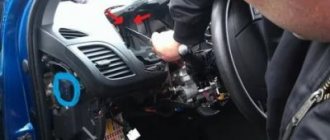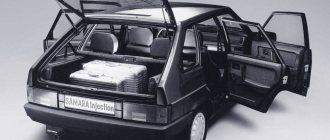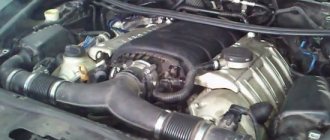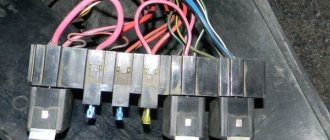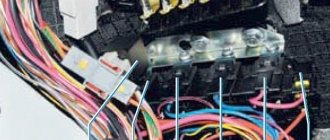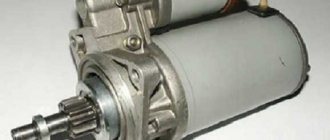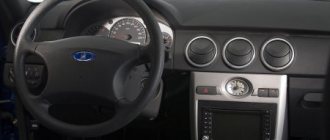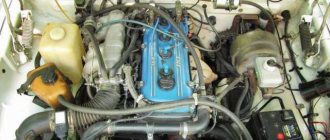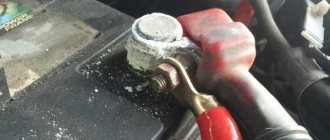Engine starting problem is a very common problem that most vehicle drivers face.
There are many reasons why your Kia Rio won't start. This could be a simple starter malfunction or more serious problems, including a faulty fuel pump or a completely discharged battery.
Battery and electrical circuits
A discharged battery and oxidation of the terminal contacts are the most common cause of engine failure, which is easiest to detect and eliminate without the involvement of car service specialists.
It’s easy to check the operation of the battery: there is a charge indicator on the dashboard; if there is insufficient power to initially turn the starter, its indicator will drop to zero, and the headlights will be dim.
The solution to the problem is to fully charge from a stationary charger, or while driving from a generator. In this case, the engine can be started from another battery, or you can try to directly jumper the starter if the indicator level is at least 20%. It is worth remembering that this is only permissible with a manual transmission.
A drop and loss of voltage in the electrical circuit of the power cable from the battery to the starter occurs due to the formation of oxides, contamination on the contacts or loosening of the bolted terminals. To eliminate them, it is necessary to clean the contacts on the starter and battery, checking the reliability of their connections.
How to open the trunk of a Kia Rio without a key?
Sometimes the locks in a car can freeze or simply jam. We discussed how to open a car above, now we’ll figure out what to do with a closed trunk.
To solve the problem of a jammed car trunk lock, there are two effective methods:
- opening the trunk from inside the car;
- unlocking the lock from the outside.
The first option is simple and reliable. If you have access to the vehicle interior, you should simply fold down the passenger seat and reach the trunk lock with your hand.
If the keys have been forgotten or there is simply no way to open one of the car doors, a method of opening the trunk using scrap materials is ideal.
To open the lock from outside the car you will need:
- several small wooden blocks;
- screwdriver;
- a long thin object.
Opening the trunk from the outside is carried out in several stages:
- Wedging a screwdriver between the trunk lid and the body.
- Expanding the resulting gap using wooden beams of varying thickness.
- Unlocking a locked lock using a thin piece of steel wire.
In such a trunk opening scenario, the alarm will definitely go off. Therefore, you need to think in advance about how to explain your actions to the authorized body.
A little about the history of the model
The first generation of Kia Rio appeared back in 2000. Then the car was equipped with a 1.5 liter engine, 5-speed manual and 4-speed automatic. If the base engine produced only 95 hp, then the models exported to the USA were more powerful. The 1.5 l was similar, and the 1.6 l produced about 105 l/s. Models for the European market were equipped with a 1.3 liter power unit with a capacity of 75 l/s.
In 2005, the second generation appeared. Korean cars were also sold in sedan and hatchback body styles. The consumer was offered a choice of three power units:
- 1.4 liters with a capacity of 95 l/s;
- turbocharged diesel with a volume of 1.5 liters and a power of 110 l/s;
- a modernized version of the 1.6-liter engine with a power of 112 l/s.
The latest generation has been produced from 2011 to the present day. There are several powertrain options: 1.4 and 1.6 liters. The model in the basic configuration costs 650 thousand, and in the maximum configuration – 850 thousand rubles.
Why doesn't the car start?
Despite all the reliability of Korean cars, they periodically fail. There is no escape from this, although in most cases the driver is to blame for not performing vehicle maintenance on time. Nevertheless, the problem that has arisen must be solved in any case. But not every driver knows how to do this and where exactly to start.
Before looking for a solution to a problem, you need to understand its possible source. As a rule, KIA RIO does not start if there are defects in the following systems:
- fuel supply;
- ignition;
- defect in the engine or control unit.
In other cases, the KIA RIO car will start. It may not work as expected, but in 90% of cases it will be able to start. Essentially, we have three groups of reasons, each of which must be considered in more detail.
Immobilizer
Perhaps one of the most vile systems that causes problems for Kia Rio owners within a year. It looks like this: the starter turns, but the car does not start. The car starts 5–7 times. Sometimes the car starts the first time, but the problem occurs again. Maybe the battery in the ignition key is dead? We change it, but the car won't start again. What is the reason? You need to look towards the immobilizer. First, check the contacts on the block. The terminal contacts often oxidize, or moisture gets inside. We clean, dry, and see the result.
Immobilizer operation diagram
If everything is the same, we inspect the antenna. Cleaning contacts. If the immobilizer does not respond, we replace the antenna with a new one. If an immobilizer bypass was installed in the car, be sure to check it. Often the reason is precisely the lineman - replacing it solves the problem forever.
Ignition system
After checking the electrical wiring and battery charge level, the Kia Rio 3 ignition system is diagnosed, which consists of four working components:
- Ignition coil
- ECU controller unit
- Five different sensors (air meter, coolant temperature, throttle, camshaft position and angle)
- Power cables and spark plugs.
First, check the operation of the high-voltage wire that goes from the ignition coil to the distributor.
The cable tip is disconnected from the distributor by removing it from under the cover and brought to any part of the car where there is mass, leaving a gap of 5-7 mm. Then turn on the ignition briefly until the starter turns - if there is a powerful spark, then the power cable is in order. Next, remove the distributor cap and inspect the contacts for contamination and oxides. If moisture gets under the cover on the distributor during engine starting, a drop in discharge occurs with possible short circuits.
It is necessary to clean the contacts with fine sandpaper, clean and dry their connectors. In the same way, check the high-voltage wires from the distributor to the spark plugs - they should be dry and clean, and the contact tips should not have traces of oxidation.
The entire operation of the ignition system can be checked in a simple way: unscrew the spark plugs from the cylinder block, connecting them into a bundle with a soft wire along the threaded parts of the connections. In this case, you need to pay attention that the wire is in contact with each spark plug without touching the central electrodes. The other end of the wire is connected to ground and the ignition is turned on until the starter starts. If all spark plugs spark, then the system is OK.
The ignition coil is also checked for voltage: if, after turning the key in the ignition switch, voltage is not supplied to the coil, and all low-voltage contacts are secured, then it must be replaced. Checking the voltage on the ignition coil:
- Disconnect the negative terminal on the battery
- Disconnect the power cable and contacts on the coil
- Remove the coil by unscrewing the four mounting bolts
- Remove the connector
- Turn on the ignition (key to “ON” position)
- Measure the voltage between the ECU and B+ terminals at the connector. The indicator should be 12 V.
Electronic sensors and the control unit are diagnosed with special equipment via the ODB-2 connector; if this is the cause, then an auto electrician will be required.
Let's sum it up
So we have dealt with breakdowns that can lead to a lack of engine response to turning the key in the ignition switch. In fact, there are a lot of reasons for such problems. It can be simply impossible to find and eliminate them on the spot. Changing components from smaller to larger is also wrong: with such success you can go through half the car, but still not achieve a result.
It's fair to do a diagnostic first. If this is not possible, you need to look for it yourself. In practice it's not that difficult. For example, by unscrewing the spark plugs and looking at them, you can immediately understand whether fuel is being supplied at all. If yes, then you need to check the wires, and if not, the pressure in the rail, wash the injectors on the stand using ultrasound. The presence of a scanner for diagnostics significantly narrows the search range, although if the problem is mechanical, then the electronics, unfortunately, will not show it.
Bad mass
The worse the grounding, the more problems with starting. If the battery is in order, the relay does not click and does not turn the Kia Rio starter, you need to look at the ground wires. In general, poor contact between the “mass” is a common illness among “Koreans.” The factory does not bother with the quality of the ground wires - sometimes the terminals are simply screwed on with paint. Wire 918604L200 is especially troublesome. Dirt and moisture get onto the terminals, so the contact quickly oxidizes. At some points the wire simply breaks, which is why the starter does not turn. Problems begin not only with the launch. On Kia Rio, sensors, alarms, autostart and the engine control unit itself are faulty.
Kio Rio ground wire
People struggle with the problem in different ways - someone changes the wire to a new one (factory or reinforced), someone throws additional “mass” on the body. Both methods have the right to life, so you can choose either one.
DIY mechanism repair
The procedure consists of stages: device removal, replacement or repair and installation, and will be discussed using the Kia Rio as an example. On other Kia models it is performed similarly.
Places of fastenings and terminals
Dismantling consists of the following steps:
- The negative terminal from the battery is disconnected.
- Next, dismantle the intake manifold and disconnect the wiring from it.
- Disconnect the wiring from the device and the positive terminal of the battery.
- The starting device is secured with two bolts. We unscrew them and dismantle the unit.
Before disassembling the starter, you should make sure that it is not working using simple tests (video author - ProGarage).
How to replace spark plugs?
This is quite easy to do on a Kia Rio. The first step is to pull off the high-voltage wires from the spark plugs, unscrew the old spark plugs and screw in the new ones. The latter are best ordered original. They have a fairly high service life and decent quality. Another important nuance is the tightening torque. It should be about 20-25 Nm. If you overtighten the spark plug, you can damage the thread so much that you will have to drill it out later. If the tightening torque is insufficient, then further unwinding from vibration is possible, which will be accompanied by tripping of the power unit. Replacing spark plugs on a Kia Rio should be done every 60,000 kilometers. But if the car is used in harsh climatic conditions or in the city, then it is better to replace it more often.
Starting system
Malfunctions in the starting system occur due to starter malfunctions. There are five reasons for failure:
- The starter does not respond when the key is turned in the ignition coil: the solenoid relay does not work, there is an open circuit or short circuit in the electrical circuit at the contact terminals.
- The starter operates without starting the engine with characteristic clicks: malfunctions in the electrical wiring, malfunction in the winding of the traction relay or armature.
- The starter turns slowly, the engine does not start: the traction relay does not work, contamination and broken contacts on the brushes, commutator, short circuit in the armature winding.
- The starter operates without turning the flywheel with possible noise, grinding: mechanical failures in the elements of the drive gears, gear teeth, return or buffer springs, lever, or loosening of the starter fasteners to the engine crankcase.
- The starter continues to operate after starting - in this case, it is necessary to turn off the engine: the contacts of the traction relay are closed, the return clutch is broken.
Depending on the nature of the malfunction, you can operate the engine, drive to the nearest car service center and fix the problem, or replace the starter with a new one.
Signaling
Starting problems also occur due to the alarm. This often happens when the power is turned off, that is, when the terminal was removed during repairs or the battery was changed. Our alarm system thinks that the car has been stolen and is blocking the start. Depending on the model, the starter is blocked (due to which it does not turn), or the fuel pump is blocked (the engine turns, but does not start). You can solve the problem by setting the alarm to service mode. In some models, this can be done from the key fob, but often you have to climb to the block itself, which is usually hidden in the depths of the panel.
Kia Rio alarm unit
Other “adventures” also happen - the fuse of the signaling unit or relay burns out. Having replaced the relay or fuse, the car starts as if nothing had happened.
All systems are working, the engine does not start
Very rarely, there is another problem due to which it is impossible to start the engine, despite the fact that all systems are working correctly, the Kia Rio battery is fully charged, and the starter is in good condition. It consists of a belt drive of the camshaft (except for Rio 3 engines - there is a chain). Experts recommend diagnosing it every 50-60 thousand kilometers. But there are certain difficulties here, and without the appropriate experience it will be difficult to overcome them. If the belt wears out, the valve timing is disrupted, making it impossible to start the engine. The difficulty when replacing it lies in dismantling the protective casing.
When the timing belt has reached the end of its life or is installed incorrectly, a problem with starting the engine is extremely likely.
After replacing the Kia Rio timing belt, the problem should be solved. It also happens that during prolonged use of a worn-out camshaft drive belt, the valves and gas distribution mechanism are damaged. In this case, more expensive and serious repairs will be required.
Return to contents
The reason is the wiring
If the Kia Rio has trouble starting, inspect the electrical wiring. Sometimes oxidation appears at joints and marks. Because of this, the electrical connection deteriorates until it is completely lost. In order to get rid of this problem, clean the oxidized areas with a brush or sandpaper . In addition, buy lubricants in stores to clean and protect electrical connections.
If the contacts are clean, try moving them. Constant vibration can cause the connection to become loose. If there is play, tighten or tighten the terminal.
Sometimes the Kia Rio 3 does not start due to the fact that the clamps on the battery contacts become loose or oxidize. A sign is a white or greenish coating around the terminals. This plaque consists of an acidic environment, so it is better not to touch it with your hands. It is necessary to carefully remove the clamps and clean everything with a wire brush or sandpaper. If you don’t have a brush, you can clean off the deposits with a screwdriver or other improvised means. Then try to start the car again.
Thick oil
It is advisable to change engine oil before winter. It's not just about wear, but also viscosity. For the winter, it is better to choose a thinner oil for Kia Rio. In winter, it is difficult for the starter to turn the crankshaft, which is in thick, frozen oil.
Motor oil viscosity
Which viscosity should I choose? You need to think correctly - not every motor can handle 0W. In the case of the Kia Rio, we look at the tolerances and see that the most “liquid” oil is 5W. Most Rio owners use 5W30 oils. Synthetics or semi-synthetics is everyone’s business.
It is important to know! Using viscous oil, the engine will experience oil starvation when starting - the lubricant cannot pass through the pump in full. After winter, seizures may form on such an engine.
Fuel supply system
The main indicator in the fuel supply system is pressure. When the ignition is turned on, the fuel pump should start; its operation can be heard before starting. If the ignition works, the starter turns, but the engine does not start, then you need to check the electrical circuit and power to the fuel pump. It is worth considering that a working electric fuel pump starts together with the ignition and creates pressure in the lines. That is, during a short-term repeated attempt to start the engine, this pressure is maintained, which means it is in good working order. Low pressure or its absence in the fuel system is due to three reasons:
- Mechanical failure of fuel pump elements
- Severe contamination of the main fuel filter module or air filter
- Malfunction of the fuel system pressure regulator, fuel sensor failure
The electrical circuit of the fuel pump is first checked from the contacts on the fuses and relays to the wiring and condition of the terminals on the unit itself.
If the electrical wiring is in order, the relay is working and voltage is supplied, then the fuel pump is faulty. The Kia Rio 3 is equipped with a distributed fuel injection system - any illiterate intervention in its elements can lead to more serious consequences, therefore, if faults are detected in the fuel system, you must contact specialists.
How to open a Kia Rio key fob?
Often the culprit for a locked car is the battery built into the key fob. As a rule, an unpleasant signal hinting at the imminent failure of the battery is a significant reduction in the range of the electronic key.
The absence of a radio signal from the key fob prevents the vehicle's central lock from opening and completely blocks the doors. In such a situation, you should simply replace the battery in the key fob.
The complete key fob for the Kia Rio uses a three-volt CR2032 battery as a battery.
To replace it, you will have to disassemble the electronic key according to the following algorithm:
- Removing the mechanical key.
- Removing the side plastic plug. At this stage you should apply a little force.
- Direct battery replacement.
The electronic key in the premium configuration of the Kia Rio car is understood somewhat differently.
To disassemble such a key fob you need:
- Remove the metal components by pressing the button at the top of the key fob.
- Using a sharp object, separate the halves of the plastic case and unclip the fasteners.
- Replace the battery.
Preventing starting problems
Every Rio owner, regardless of the generation of the car and the type of transmission (manual or automatic), must clearly remember the following rules:
- The engine compartment should always be clean (this also applies to the power unit);
- it is necessary to constantly monitor the state of charge of the battery, wires, serviceability of the starter and spark plugs;
- periodically inspect the contacts and remove the oxide film and pockets of corrosion from them;
- change filters in a timely manner;
- Do not neglect carrying out scheduled maintenance at a specialized auto repair center.
It is worth emphasizing here that the unsatisfactory condition of the electrical wiring in the engine compartment is not only one of the reasons why the engine will not start, but can also cause a car fire.
Return to contents
What do the starter clicks mean?
As was said at the very beginning of the article, the problem may be completely trivial. For example, they forgot to turn off the headlights or left soft music on after work. It is quite natural that the battery will be discharged before the morning. And if the battery has already worked for several years, then this can happen without additional sources of energy consumption during a winter night. In this case, the starter simply clicks. The Kia Rio does not start in this case, which is quite logical.
The problem that has arisen can be solved in several ways - by replacing or charging the battery. If the battery dies due to the driver’s fault, then it will be enough to charge it. Modern batteries are in most cases maintenance-free, so you don’t need to add anything to them. The gentle charging mode of 2-4 amperes takes a lot of time, but allows you to completely restore energy. For example, a 60 A/h battery with a current of 5A must be charged for 12 hours. Well, replacing the battery is generally a simple matter. There are a lot of worthy manufacturers, the average service life is about 5 years, and this is if the battery is not subjected to deep discharges.
What to do if the car doesn't start?
The main thing is not to panic. It is quite possible that the reason why the power unit does not start is quite trivial, and it is enough to do a few simple steps (for example, check the condition of the battery, spark plugs, etc.) to eliminate it. For more serious problems, the help of a qualified technician will be required. It is possible that the car will have to be transported to a service station. We emphasize that for Kia Rio with automatic transmission, towing is strictly prohibited, otherwise, there is a risk of transmission failure.
Tags: Battery, Engine, Won't start, Rio, Spark plugs
How to open the driver's door on a Kia Rio without a key?
If the door of a Kia Rio suddenly closes, you can use several methods to solve this problem.
Before you open the Kia Rio without keys, you need to make sure that:
- no spare set of keys;
- All car windows are completely closed and cannot be used to unlock the doors.
One of the most obvious ways to open a door involves the following steps:
- creating a small gap between the driver's door and the body;
- widening the gap using scrap materials;
- prying the opening handle from the inside using a thin knitting needle or a long piece of steel wire.
This method is very effective, but it is not suitable for everyone. The key disadvantage of emergency opening by bending the door is significant damage to the body and deformation of the door.
When opening a door with a bend, it would be a good idea to have a special inflatable bulb. Such a tool is inexpensive and will be very useful if it is necessary to widen the gap. To use the pillow, you need to squeeze it into the slot and fully inflate it.
An air-filled airbag will greatly simplify access to the door or trunk lock in the event of force majeure.
If serious bending of the door is not possible, you can try this method:
- Open the door minimally.
- Use a long thin object to press the trunk handle.
- In the trunk, unscrew the bolts securing the sofa.
- Climb through the lowered sofa into the salon and open it from the inside.
With this opening option, the integrity of the body suffers much less. The only drawback of opening through the trunk is the inaccessibility of the fastening elements of the rear seats of the car.
People with large hands will find it very difficult to reach the three nuts hidden in the luggage compartment of the car.
Some useful tips
The manufacturer indicates clear deadlines for replacing certain consumables and servicing a wide variety of components. It is advisable to follow these tips and not leave your car unattended. A timely serviced timing belt is the key to a long life for your engine. Its resource is reduced by bad spark plugs, low quality oil and many other factors.
If the next morning the car refuses to start, then in most cases this indicates the presence of serious malfunctions, although sometimes you can get off quite easily. If the crankshaft sensor fails, then it needs to be changed in any case; there is no point in repairing it. It costs a lot, but without it there won’t even be a spark. Often the sensor remains in a “half-dead” state for quite a long time. Therefore, it happens that the Kia Rio does not start the first time. This is due to the fact that the crankshaft sensor periodically sends incorrect data to the electronic control unit, which regulates engine starting parameters.
Checking high voltage wires
The test is carried out on the central wire. The end part is removed from the distributor. Bring the tip closer to any metal element of the car that is well connected to the ground (“bare”, painted - no difference) at a distance of 4-8 mm from each other.
The engine is cranked by the starter, that is, it is as if we are trying to start with the key. If a spark is present, which can be confirmed by a strong click, then the scope of troubleshooting is narrowed. You need to look under the distributor cap. There may be water there. In this case, the current does not reach the spark plug. The distributor must be cleaned and dried. If possible, carry out the same procedure with contacts - for example, with 220-grit sandpaper.
When examining, pay attention to the “runner”. Sometimes there is a dark mark on it, indicating a breakdown. Treatment is only a replacement.
The second stage is checking each wire running from the distributor to the spark plug. There are no signs of deformation - the distributor cover is closed and the connection is restored. They try to start the car. It is either starting to work properly or is already showing signs of improvement. However, after the procedure you will have to unscrew the candles, because they are now filled with gasoline. Even if the car is again in the “starter turns but does not start” mode, this manipulation will still be required. Inspection, cleaning, and replacement will not be superfluous.
You can check the ignition system with the spark plugs removed. The procedure is as follows:
- a high-voltage wire is connected to the unscrewed spark plugs;
- devices are collected in a bundle;
- along the threaded part they are wrapped together with soft wire, which must be in contact with each candle, but not in contact with the electrodes;
- the wires are attached to the mass.
We turn the engine again with the starter. A spark should jump between each electrode in turn. Then the system is fine.
However, it happens that there is no spark, and this suggests that the high-voltage circuit has nothing to do with it. Diagnosis becomes more difficult. Using a tester, the voltage supplied to the ignition coil is checked. If it is absent, it is obvious: the ignition coil is faulty and needs to be replaced. It happens that dirt gets clogged here, and the current goes anywhere, but not to the spark plug. When cleaning does not help, the coil is truly faulty.
For electronic ignition (for example, there is a switch or sensor in the distributor housing), it will not be possible to make a diagnosis without special equipment.
There are contacts under the 2nd generation Korean distributor cover. Sometimes they oxidize and require sanding with fine sandpaper. Afterwards, the contacts need to be moved a little to close and open the circuit. 12 volts won't do any harm. No tension appears, which means a more difficult stage lies ahead. It is difficult to cope with it on your own.
The appearance of voltage restores the circuit and the car starts. However, it happens that there is no start again, although attempts to turn on appear. Then we return to the stage of turning out the candles.
